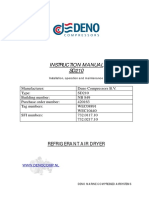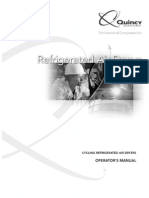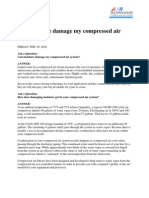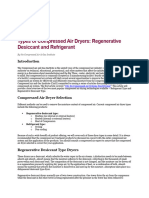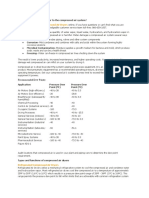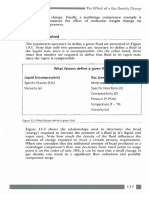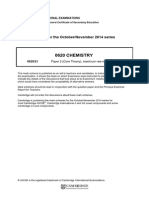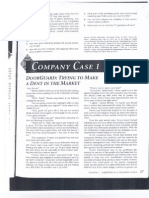Reciprocating Air Compressors
Reciprocating Air Compressors
Uploaded by
Aatish ChandrawarCopyright:
Available Formats
Reciprocating Air Compressors
Reciprocating Air Compressors
Uploaded by
Aatish ChandrawarCopyright
Available Formats
Share this document
Did you find this document useful?
Is this content inappropriate?
Copyright:
Available Formats
Reciprocating Air Compressors
Reciprocating Air Compressors
Uploaded by
Aatish ChandrawarCopyright:
Available Formats
Preparing Reciprocating Air Compressors for Winter
| Compressed Air Best Practices
https://www.airbestpractices.com/technology/air-compressors/preparing-reciprocating-air-
compressors-winter
By the Compressed Air & Gas Institute
Are you preparing for winter? Your reciprocating air
compressor needs to as well.
The colder months are upon us, and your compressed air system
maintenance routine can be more complex in colder climates. Freezing
temperatures can have negative effects on your reciprocating air
compressor, dryer, and many accessories. One of the best practices to adopt
is keeping a detailed maintenance log. At the end of each season, take note
of the condition your equipment is in, and address it promptly using the
manufacturer’s instructions to keep it operating smoothly and efficiently.
Most reciprocating compressors are designed to operate in temperatures
above 40°F (4°C). If your system is not in a temperature-controlled indoor
environment, your machine could sustain short-term and long-lasting
damage.
Most reciprocating compressors are designed to operate in
temperatures above 40°F (4°C).
Here is a list of best practices for preventative maintenance in cold weather
in order to maintain efficiency and ensure consistent operations:
1. Change Filters and Oil
Clear air filters are essential to your system’s operation. A clog can lead to
contamination and cause pressure drops. Ensure your oil is rated for
ambient temperatures and consistently remains fluid throughout the
season. Lubricant can thicken during colder weather, causing your
reciprocating compressor to be less effective and overload the motor,
putting undue wear on the compressor.
2. Clean the Exterior
Keeping the outside of your reciprocating compressor clean can prevent
corrosion and make it easier to spot oil leaks. It also allows you to examine
all the air compressor’s components for safety concerns, as well as wear
and tear. Along with the exterior, check the feet and mounting of the
reciprocating compressor. Worn or damaged feet can cause unnecessary
vibration, which could lead to operational issues.
Maintaining air compressor room temperature around 45°F (7°C) will
significantly assist in keeping your system up and running.
1. Check Compressed Air Dryers, System Drains, and Tanks for
Moisture
In cold weather conditions, dryers and drains must be closely monitored, as
℉
they cannot properly operate below 32 (0°C) without proper freeze
protection. The heat exchanger in a dryer can become damaged and
blocked when moisture is allowed to freeze. Freezing in a refrigeration
dryer can also cause cracking and damage to components. In extremely
cold weather, drain valves can also freeze open or closed, preventing
proper operation. Freezing in drain valves can also cause cracking in the
housing, requiring repair resulting in downtime. Tanks can also collect
condensation that is susceptible to freezing, and therefore, it must be
checked regularly during the colder months.
2. Weatherproof the Air Compressor Room
Consider providing ambient temperatures around your compressed air
system by installing heaters or proper ventilation methods. This space does
not need to be heated to the same levels required for human comfort.
However, maintaining the room temperature around 45°F (7°C) will
significantly assist in keeping your system up and running. Freezing
weather can cause frozen moisture to accumulate on or in your
reciprocating air compressor. This freezing and thawing of the moisture
will cause stress on the components of the equipment. The stress from
freezing and thawing can compromise the equipment’s structure and
weaken it prematurely.
When you properly prepare and maintain your compressed air system
during the colder months, you and your company will benefit from the
following:
Consistent production and limited downtime
Reduced operational or repair costs
Reduced moisture damage on products
Energy savings
Environmentally sound operation
Every manufacturer has a specific maintenance schedule and safety
requirements to do proper service. Always refer to the original
manufacturer’s operator manual before performing service or repairs.
You might also like
- Complete Download Power System Analysis and Design 6th Edition J. Duncan Glover - eBook PDF PDF All ChaptersDocument41 pagesComplete Download Power System Analysis and Design 6th Edition J. Duncan Glover - eBook PDF PDF All Chapterspulataekki100% (4)
- Water Cooled Chiller - SOPDocument13 pagesWater Cooled Chiller - SOParunceedee100% (4)
- Commercial RefrigerationDocument11 pagesCommercial RefrigerationBenjie flor CalayegNo ratings yet
- Chiller Aq SerieDocument59 pagesChiller Aq SerieJose Chavez VillaNo ratings yet
- Acuchiller Thermal Care AQ1W2504ZDocument59 pagesAcuchiller Thermal Care AQ1W2504Zorlinguerrero0% (1)
- Pile CapDocument1 pagePile CapUlul Azmi AINo ratings yet
- 7525 Lexmark X543-X544-X546.service ManualDocument351 pages7525 Lexmark X543-X544-X546.service ManualwilbingNo ratings yet
- Goal Programming: Multiple Objectives and Minimization of Goal Deviational VariablesDocument19 pagesGoal Programming: Multiple Objectives and Minimization of Goal Deviational VariablessudipitmNo ratings yet
- DENAIR User Manual For Refrigerated Air DryerDocument16 pagesDENAIR User Manual For Refrigerated Air Dryerrigsme032No ratings yet
- Air Conditioning Circuit and Cycle DiagramDocument4 pagesAir Conditioning Circuit and Cycle DiagramAlberto Villanueva100% (2)
- Hydrovane Refrig Dryer-HV04-05-07 PDFDocument13 pagesHydrovane Refrig Dryer-HV04-05-07 PDFMark CarterNo ratings yet
- Benefits of All Electric Systems Over Diesel Trailer StorageDocument12 pagesBenefits of All Electric Systems Over Diesel Trailer Storageeddie2166No ratings yet
- The Case For A RefrigerationDocument21 pagesThe Case For A RefrigerationNadia DelibasicNo ratings yet
- Deno Air Dryer Manual SD210 16757Document58 pagesDeno Air Dryer Manual SD210 16757ImmorthalNo ratings yet
- Chill Out! - The Importance of Keeping Your Compressed Air CoolDocument2 pagesChill Out! - The Importance of Keeping Your Compressed Air CoolA.K.M. MOBAROKNo ratings yet
- Preventive Maintenance - Keeping Refrigeration Equipment in ShapeDocument5 pagesPreventive Maintenance - Keeping Refrigeration Equipment in ShapeSanjay RanaNo ratings yet
- 2.3operator Manual of SDLF-80Document27 pages2.3operator Manual of SDLF-80pachara sarntiyakulNo ratings yet
- Defrost MethodsDocument18 pagesDefrost Methodse4erkNo ratings yet
- Air Dehydrator (Macmac)Document5 pagesAir Dehydrator (Macmac)Mark Joseph Nambio NievaNo ratings yet
- QPCD Instruction Manual 9829211462Document24 pagesQPCD Instruction Manual 9829211462scribidingyNo ratings yet
- BE-Aerospace-Filter Replacement of Air ChillerDocument3 pagesBE-Aerospace-Filter Replacement of Air ChillerJason JiaNo ratings yet
- Choosing an Air Compressor Cooling System _ Fluid-Aire DynamicsDocument16 pagesChoosing an Air Compressor Cooling System _ Fluid-Aire Dynamicsedos izedonmwenNo ratings yet
- Manual SD210 18905 PDFDocument58 pagesManual SD210 18905 PDFdamithadesilvaNo ratings yet
- Instruction Manual: Refrigerated Compressed Air Dryer Installation Operation MaintenanceDocument24 pagesInstruction Manual: Refrigerated Compressed Air Dryer Installation Operation MaintenanceHugh O'Brien GwazeNo ratings yet
- Best Practice Manual Hvac Chillers-41-45Document5 pagesBest Practice Manual Hvac Chillers-41-45ambrose rNo ratings yet
- 2009-08 EMOs For Cooling SystemsDocument4 pages2009-08 EMOs For Cooling Systemsnikola ilicNo ratings yet
- Instruction Manual Smard SC 18: Installation, Operation and MaintenanceDocument14 pagesInstruction Manual Smard SC 18: Installation, Operation and MaintenancerazvanNo ratings yet
- Chiller Service 2Document8 pagesChiller Service 2VENKATNo ratings yet
- Manual de Usuario KooltronicDocument16 pagesManual de Usuario Kooltronicaldariz201181No ratings yet
- AKG TS Installation ManualDocument6 pagesAKG TS Installation ManualFELICIANO ROBLES RAMOSNo ratings yet
- Can Moisture Damage My Compressed Air SystemDocument5 pagesCan Moisture Damage My Compressed Air SystemRam RanjanNo ratings yet
- HVAC MaintDocument13 pagesHVAC MainthmnnhgczdmNo ratings yet
- User Guide Packaged Sistems Bard PDFDocument9 pagesUser Guide Packaged Sistems Bard PDFMADENo ratings yet
- Air-Cooled Chillers Maintenance & Inspection ChecklistDocument3 pagesAir-Cooled Chillers Maintenance & Inspection Checklistdjukal100% (2)
- Moisture Loss During FreezingDocument1 pageMoisture Loss During FreezingIvana TomazNo ratings yet
- DHN Refrigerators and FreezersDocument4 pagesDHN Refrigerators and FreezersGamedr0id78No ratings yet
- Air Conditioning 3Document36 pagesAir Conditioning 3kapun kumar nayakNo ratings yet
- Solving The Mystery of Economisers 1209Document4 pagesSolving The Mystery of Economisers 1209ptrvkrynNo ratings yet
- Air Conditioning Fact SheetDocument6 pagesAir Conditioning Fact SheetrjchpNo ratings yet
- CAGI Article Types of Compressed Air DryersDocument5 pagesCAGI Article Types of Compressed Air DryersHalima LAARARINo ratings yet
- Rocky Refrigerated Air Dryer ManualDocument23 pagesRocky Refrigerated Air Dryer Manualirfanammar1984No ratings yet
- How Air Conditioning Systems Work and Fail.Document3 pagesHow Air Conditioning Systems Work and Fail.Rachel PetersNo ratings yet
- 9 Air Conditioner Maintenance and Care TipsDocument6 pages9 Air Conditioner Maintenance and Care TipsJose Gomez HernandezNo ratings yet
- Air Conditioning SystemDocument9 pagesAir Conditioning SystemRafique PiraniNo ratings yet
- SuperSnow Bus AC Instruction Manual Rev1Document26 pagesSuperSnow Bus AC Instruction Manual Rev1lopezhernandezesvincrNo ratings yet
- Refrigerated Air Dryer Manual - 1Document24 pagesRefrigerated Air Dryer Manual - 1Darshana AbeyratneNo ratings yet
- Industrial Air Conditioning SystemDocument18 pagesIndustrial Air Conditioning SystemSarita Bali Srivastava100% (3)
- Compressed Air Dryers: Recommended Dew PointsDocument11 pagesCompressed Air Dryers: Recommended Dew Pointsjenish parekhNo ratings yet
- Ac 1Document22 pagesAc 1Srivalli BNo ratings yet
- MracDocument91 pagesMracJaphet GabatanNo ratings yet
- Air Cooled ChillerDocument4 pagesAir Cooled Chilleraad_180No ratings yet
- Why Do Compressed Air Systems Need Drying?Document4 pagesWhy Do Compressed Air Systems Need Drying?maddukuri jagadeesh babuNo ratings yet
- AC Servicing Guide enDocument22 pagesAC Servicing Guide enaiigee100% (2)
- Air Cooled Water Chiller User ManualDocument36 pagesAir Cooled Water Chiller User ManualReynaldoNo ratings yet
- Safety Precaution in Air Conditioning ServicingDocument2 pagesSafety Precaution in Air Conditioning ServicingMuhd Nasri100% (1)
- MD Radzuan A Rahman - PM - TUGASANDocument4 pagesMD Radzuan A Rahman - PM - TUGASANSyafiz NawawiNo ratings yet
- How To Select A Compressed Air Dryer - Van Air SystemsDocument3 pagesHow To Select A Compressed Air Dryer - Van Air SystemsHemchand MoreNo ratings yet
- Ice Qube ManualDocument16 pagesIce Qube ManualGiorgio FerNo ratings yet
- Refrigeration Efficiency - U5: Keep Your Cool - Keep Your CashDocument5 pagesRefrigeration Efficiency - U5: Keep Your Cool - Keep Your Cashbookslover1No ratings yet
- Industrial Air ConditioningDocument9 pagesIndustrial Air ConditioningAshish NautiyalNo ratings yet
- HV 2210Document21 pagesHV 2210Janarthanan NagalingamNo ratings yet
- Equipment and System Dehydrating, Charging, and Testing: Related Commercial ResourcesDocument7 pagesEquipment and System Dehydrating, Charging, and Testing: Related Commercial ResourcesBurning TrainNo ratings yet
- Oral and Practical Review: Reflections on the Part 147 CourseFrom EverandOral and Practical Review: Reflections on the Part 147 CourseNo ratings yet
- Principles of Rotating EquipmentDocument15 pagesPrinciples of Rotating EquipmentAatish ChandrawarNo ratings yet
- REG01 - Principles-2Document15 pagesREG01 - Principles-2Aatish ChandrawarNo ratings yet
- The Factors Involved: The Effect of A Gas Density ChangeDocument15 pagesThe Factors Involved: The Effect of A Gas Density ChangeAatish ChandrawarNo ratings yet
- Oil-Free Centrifugal CompressorsDocument6 pagesOil-Free Centrifugal CompressorsAatish ChandrawarNo ratings yet
- Principles of Rotating Equipment: Gas InletDocument15 pagesPrinciples of Rotating Equipment: Gas InletAatish ChandrawarNo ratings yet
- Compressor PulsationDocument6 pagesCompressor PulsationAatish ChandrawarNo ratings yet
- Compressor ControllingDocument7 pagesCompressor ControllingAatish ChandrawarNo ratings yet
- Oil Vs Oil Free CompressorsDocument6 pagesOil Vs Oil Free CompressorsAatish ChandrawarNo ratings yet
- Five Questions and Answers About Heat ExchangersDocument4 pagesFive Questions and Answers About Heat ExchangersAatish ChandrawarNo ratings yet
- List of Approved MakesDocument7 pagesList of Approved MakesrahulkuarNo ratings yet
- Quantum Tech Fest 2024, Saveetha Institute of Medical and Technical Sciences Engineering, Technical Symposium, ChennaiDocument1 pageQuantum Tech Fest 2024, Saveetha Institute of Medical and Technical Sciences Engineering, Technical Symposium, Chennaimf42gcb8bdNo ratings yet
- Schlesinger Limits1 PDFDocument2 pagesSchlesinger Limits1 PDFJeremy PhilipNo ratings yet
- Reverse Power Relay Basics and OperationDocument8 pagesReverse Power Relay Basics and OperationHILBERTOFUNES7No ratings yet
- AccumulatorDocument12 pagesAccumulatorNaser Khan100% (1)
- Xplot For Water FloodingDocument3 pagesXplot For Water FloodingMostafa KorttamNo ratings yet
- Catalogo Frontali HF 05.2017 - 20 PGG - Finale (Low)Document13 pagesCatalogo Frontali HF 05.2017 - 20 PGG - Finale (Low)wpimientoruedaNo ratings yet
- 2020 FMC Catalogue PDFDocument197 pages2020 FMC Catalogue PDFsergio melgarejoNo ratings yet
- Exercise 1Document6 pagesExercise 1Ranie Lyn CalderonNo ratings yet
- Mechanical Vibrations Fundamentals: Lecture No. 2Document3 pagesMechanical Vibrations Fundamentals: Lecture No. 2Garcia Asmad JhonnNo ratings yet
- Serv7107 V05N01 TXT7Document32 pagesServ7107 V05N01 TXT7azry_alqadry100% (7)
- AnthropometryDocument2 pagesAnthropometryPia louise RamosNo ratings yet
- Test 2-20202021-1-SPACE KLDocument4 pagesTest 2-20202021-1-SPACE KLKaoru AmaneNo ratings yet
- 0620 w14 Ms 21Document7 pages0620 w14 Ms 21Haider Ali100% (1)
- Superblock: MCH / BCH SeriesDocument6 pagesSuperblock: MCH / BCH SeriesgamunozdNo ratings yet
- Hec RasDocument20 pagesHec RasalejoelingNo ratings yet
- Continuous Assessment Test II: March 2018 Reg. No.Document2 pagesContinuous Assessment Test II: March 2018 Reg. No.Venkatram PrabhuNo ratings yet
- Spare Parts Maestra-Mt 2010-02 (g19530524)Document80 pagesSpare Parts Maestra-Mt 2010-02 (g19530524)JohnnyNo ratings yet
- Cc4101 Advanced Manufacturing Process Jan 2022Document3 pagesCc4101 Advanced Manufacturing Process Jan 2022vvnmechNo ratings yet
- Door GuardDocument3 pagesDoor GuardOlivia GittensNo ratings yet
- Issue 48 - HSE Insights Newsletter - Process Safety Asset Integrity (AIPS)Document12 pagesIssue 48 - HSE Insights Newsletter - Process Safety Asset Integrity (AIPS)Richardson LanuzaNo ratings yet
- Resume New Electrical UpdtDocument5 pagesResume New Electrical UpdtrameshNo ratings yet
- I-P-1.01-W-4 (NOX Analyser)Document2 pagesI-P-1.01-W-4 (NOX Analyser)JCSNo ratings yet
- Easy Approach To Requirements Syntax (EARS) : October 2009Document7 pagesEasy Approach To Requirements Syntax (EARS) : October 2009Adam MazurekNo ratings yet
- Lenovo C205 Hardware Maintainece ManualDocument60 pagesLenovo C205 Hardware Maintainece ManualeloyutmNo ratings yet
- ElbowsDocument1 pageElbowsKokkieNo ratings yet













